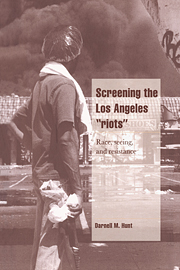Book contents
- Frontmatter
- Contents
- List of figures
- List of tables
- Preface
- 1 Introduction
- Part I Context and text
- Part II Audience
- 4 Stigmatized by association: Latino-raced informants and the KTTV text
- 5 Ambivalent insiders: black-raced informants and the KTTV text
- 6 Innocent bystanders: white-raced informants and the KTTV text
- Part III Analysis and Conclusions
- Postscript
- Appendix A Data and methods
- Appendix B Figures
- Appendix C KTTV Transcript
- Appendix D Questionnaires
- Appendix E Tables
- Notes
- References
- Index
6 - Innocent bystanders: white-raced informants and the KTTV text
Published online by Cambridge University Press: 23 January 2010
- Frontmatter
- Contents
- List of figures
- List of tables
- Preface
- 1 Introduction
- Part I Context and text
- Part II Audience
- 4 Stigmatized by association: Latino-raced informants and the KTTV text
- 5 Ambivalent insiders: black-raced informants and the KTTV text
- 6 Innocent bystanders: white-raced informants and the KTTV text
- Part III Analysis and Conclusions
- Postscript
- Appendix A Data and methods
- Appendix B Figures
- Appendix C KTTV Transcript
- Appendix D Questionnaires
- Appendix E Tables
- Notes
- References
- Index
Summary
I think one thing I can start with is that the use of violence that was shown –I think that is totally wrong. It's like there are other, better ways of, more constructive ways of doing it [protesting] rather than going out and burning things.
(white-raced informant)Throughout United States history, “white” has been defined in contrast to “black.” That is, if something was said to be white, then it was necessarily not-black; conversely, if something was said to be black, then it was also notwhite. Indeed, “black” and “white” have come to represent the ultimate in mutually exclusive categories, an essential binary opposition. Despite the increasing raced complexity of US society, the terms retain a special social meaning (see Baldwin 1961; Hacker 1992): while “black,” describes the lower-most depths of the racial order, “white” describes the uppermost reaches; while “black,” signifies primitive, inferior and soiled, “white” signifies civilized, superior and pure.
This black-white divide, as we saw in chapter 3, is inscribed in the KTTV text. That is, “blacks” were presented as the event insiders (i.e., those who participated in the events and/or were in a position to affect them one way or another), while “whites” were depicted as event outsiders (i.e., those who watched the events, reported on them, and from time to time, fell victim to them). In short, “whites” were innocent bystanders to events that were “black” in nature. This observation, of course, fits neatly with another: in the white imagination, “black” is often associated with crime (Estrich 1989; Omi and Winant 1994).
- Type
- Chapter
- Information
- Screening the Los Angeles 'Riots'Race, Seeing, and Resistance, pp. 101 - 124Publisher: Cambridge University PressPrint publication year: 1996



